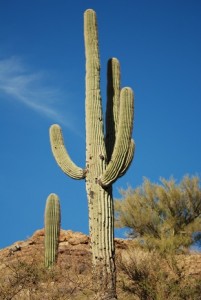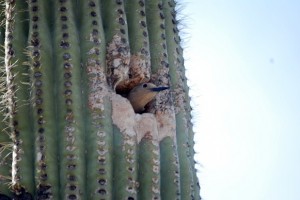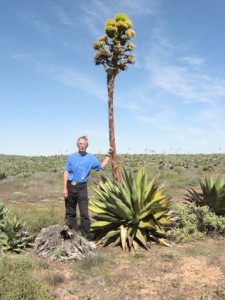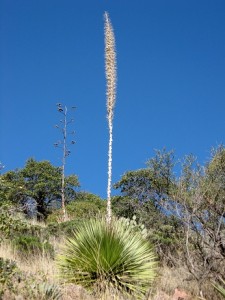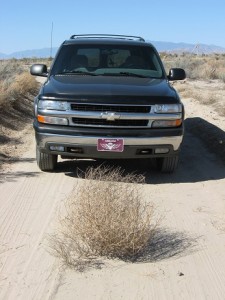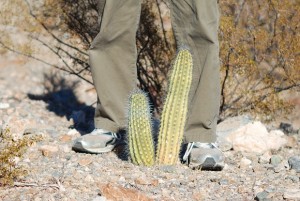
Cactus and other desert plants. Updated July 2022
I know most people like to spend their vacations on tropical beaches. But, for me, there is nothing like being in the desert. It is dry (usually), warm and filled with interesting plants and critters and not crowded. In this post, I will tell you about the many cacti and other plants I have encountered in the deserts of North America.
Barrel Cactus
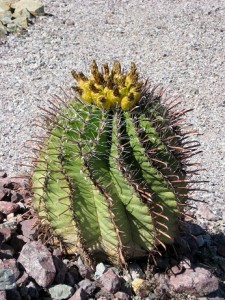 This cactus is so-named because of its barrel shape, which can grow to about one metre (three feet) in height. They bloom only after many years, producing a colourful flower on the top in April. Do not touch this cactus. The fish-hook-shaped spines are dangerous, and if it punctures your skin, you may need antibiotics to heal the wound, which could take several months. After about one month, the flower is replaced with a pineapple-shaped green fruit which is not very good to eat.
This cactus is so-named because of its barrel shape, which can grow to about one metre (three feet) in height. They bloom only after many years, producing a colourful flower on the top in April. Do not touch this cactus. The fish-hook-shaped spines are dangerous, and if it punctures your skin, you may need antibiotics to heal the wound, which could take several months. After about one month, the flower is replaced with a pineapple-shaped green fruit which is not very good to eat.
The Barrel Cactus can be used as a compass as they usually lean to the south. Sometimes they lean so far to the south that they will fall over and die.
This cactus is often planted as an ornamental plant in gardens.
Cholla Cactus
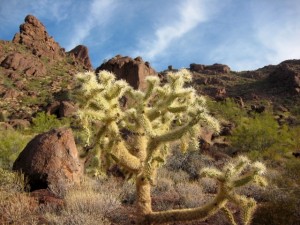
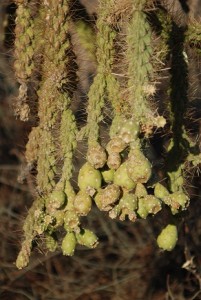 There are about 35 species of Cholla. Although I think they are kind of cute for a cactus, they can be dangerous as the hooked spines are easily removed from the plant but difficult to remove from your skin. They bloom in the spring with a yellow flower, and the fruit hangs down in clumps.
There are about 35 species of Cholla. Although I think they are kind of cute for a cactus, they can be dangerous as the hooked spines are easily removed from the plant but difficult to remove from your skin. They bloom in the spring with a yellow flower, and the fruit hangs down in clumps.
Prickly Pear
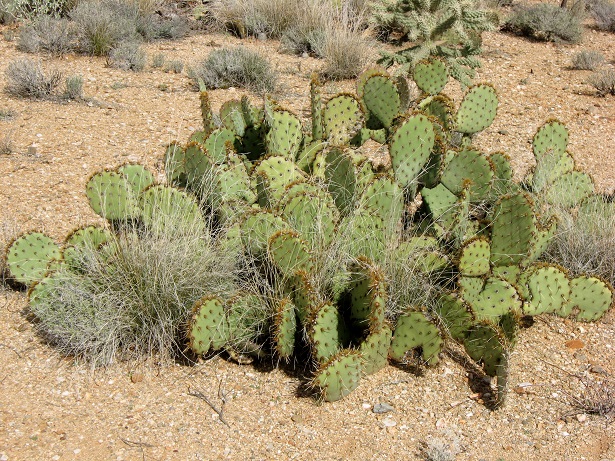
One of the most common North American cacti is the Prickly Pear. It grows in clumps of pear-shaped organs called cladodes. Each Cladode is covered with long, sharp spines. They can be of all sizes. Some are large, like a bush and cannot be missed, but others are tiny, and you may not notice them until you step on one. The spines can penetrate the soles of your boots.
The Prickly Pear is edible if you can manage to pick them and get the spines off without stabbing yourself. You then scrape off the skin, chop it up and boil or fry it. I have tried it. I thought that it tasted somewhat like asparagus, although a bit bland. If you want to try it without picking your own, Walmart and other grocery stores in Mexico sell it. It is called nopales in Spanish.
Saguaro
The huge, iconic cactus of western movies is the Saguaro. They can grow to more than 20 metres (70 feet).
Each of the four North American Deserts has unique plants that do not grow in the other deserts. The Saguaro grows only in the Sonora Desert. It is the state flower of Arizona. They first grow straight up. After about 75 to 100 years, it will grow arms that reach outwards and then upwards. This cactus can live to be about 150 years old.
If you look closely at the Saguaro and disregard the spines, you will see that the cactus is corrugated and can expand to store water when there is rain.
The Saguaro blooms in the spring with a pretty white and yellow flower that blooms only at night and is pollinated mainly by bats.
Gila Woodpeckers hollow out cavities in the Saguaro to make nests. They make a new cavity each year, and their old nests become homes for Elf Owls, flycatchers and wrens.
You can see a whole forest of Saguaro at the Saguaro National Park near Tucson. Harming a Saguaro in any manner is illegal in the state of Arizona.
Cirio
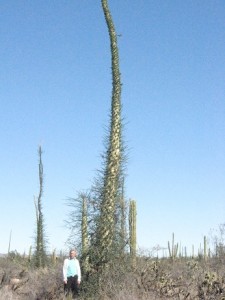
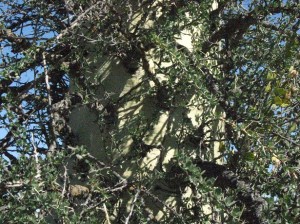 The Cirio is a strange plant. From a distance, it looks like a hairy telephone pole. However, if you get close enough for a good inspection, you will see that it is more like a telephone pole wrapped in barbed wire. You would not want to climb it. It is not a cactus but a strange type of tree. Its real name is the Boojum Tree. They can grow to a height of 20 metres. The best place to see the Cirio is in the Baja Peninsula in Mexico.
The Cirio is a strange plant. From a distance, it looks like a hairy telephone pole. However, if you get close enough for a good inspection, you will see that it is more like a telephone pole wrapped in barbed wire. You would not want to climb it. It is not a cactus but a strange type of tree. Its real name is the Boojum Tree. They can grow to a height of 20 metres. The best place to see the Cirio is in the Baja Peninsula in Mexico.
Agave
One of the most common desert plants is the Agave. There are about 200 slightly different species of Agave, but I will describe the Agave family in general. Early settlers called them century plants because they thought they bloomed only once every 100 years. However, they bloom after about 25 years and then the plant dies. When they bloom, they grow a colossal stem out of the centre of the plant that can reach several metres in height. Contrary to popular belief, it is not a cactus. In fact, it is not related to cacti at all.
The Maguey is a type of Agave that is used to make mescal, a popular alcoholic drink in Mexico. It is often sold with a worm in the bottle. The worm is the larva of a moth that infects the Maguey plant. It is said that putting the worm in the bottle improves the flavour.
Another type of Agave, called the Blue Agave, is used to make tequila, a more popular drink than mescal. Tequila is made only in Mexico.
Sotol
Commonly known as the Sotol, this plant is more appropriately called the Desert Spoon. Sotol is the name of a distilled spirit made from the plant, but it is not as popular as drinks made from Agave.
Tumbleweed
The Tumbleweed is a strange plant. When it matures, it dries out and breaks free of its roots and blows away in the wind. Then, it tumbles along until it gets snagged on something. This is the plant’s method of distributing its seeds. Eventually, the seeds take root, and a new plant will grow until it dries out and tumbles away to populate in a new location.
The Tumbleweed is not a plant at all. Several different desert plants use this method of distributing their seeds. Tumbleweed is just the name for a moving stage of the plant’s life cycle.
The Tumbleweed, like the Saguaro, is often shown in Hollywood western movies.
Yucca
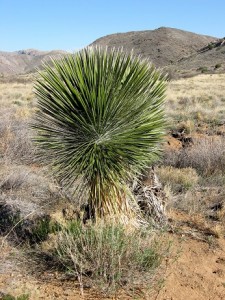 The Yucca is an interesting plant. There are several species, some look like bushes, and others are as big as a tree. When the Yucca blooms, it is pollinated only by the Yucca Moth. The plant and moth have a symbiotic relationship, and each would not survive without the other. It is the state flower of New Mexico.
The Yucca is an interesting plant. There are several species, some look like bushes, and others are as big as a tree. When the Yucca blooms, it is pollinated only by the Yucca Moth. The plant and moth have a symbiotic relationship, and each would not survive without the other. It is the state flower of New Mexico.
Joshua Tree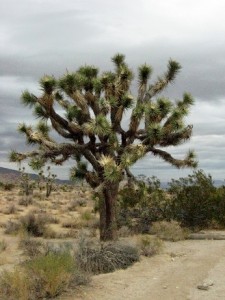
The Joshua Tree is a giant form of the Yucca plant that grows in the Mojave Desert. Although it is called a tree, it is made of fibre and does not have wood with growth rings like a typical tree and does not have leaves. Like all Yucca plants, the Joshua Tree is pollinated only by the Yucca Moth. A good place to see them is in Joshua Tree National Park in California.
Organ Pipe
The Organ Pipe cactus is so-named because it resembles the pipes of a large organ. They can reach a height of eight metres (26 feet), but they grow very slowly. Reaching this height could take about 150 years. It grows in the Sonora desert, mainly in Mexico but also on the American side of the border. The Organ Pipe National Monument in Arizona is the best place to see them. Like the Saguaro, they bloom in spring but only during the night. The pretty flowers are seldom seen as they close during the day. They produce a delicious fruit that is something like a little watermelon.
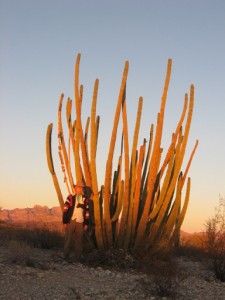
Left: Organ Pipe Cactus at 25 years old. Right: After 80 years.
Organ Pipe Cactus National Monument (government website)
Organ Pipe Cactus National Monument (my visit to this park)
